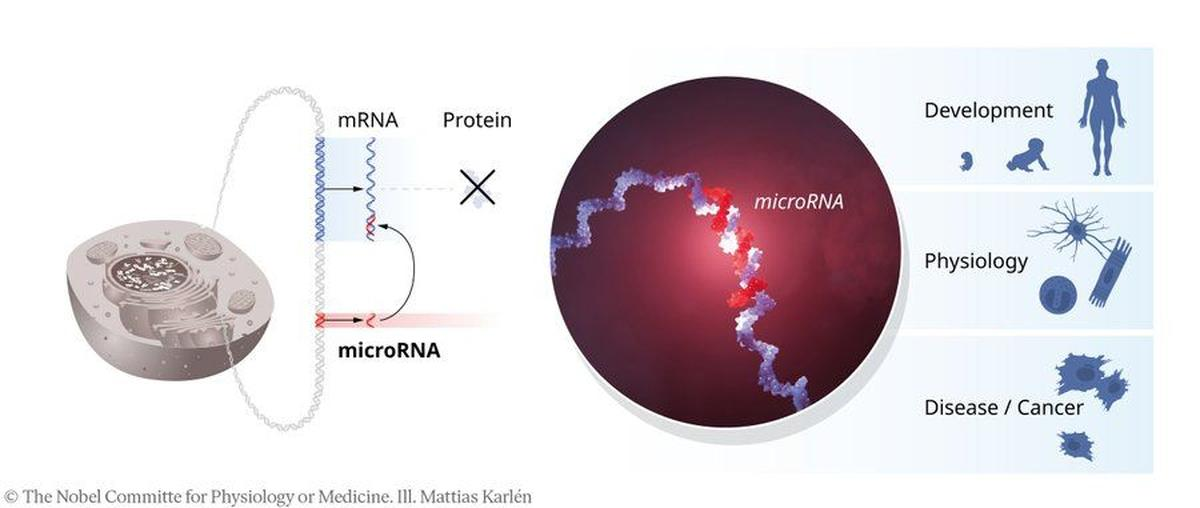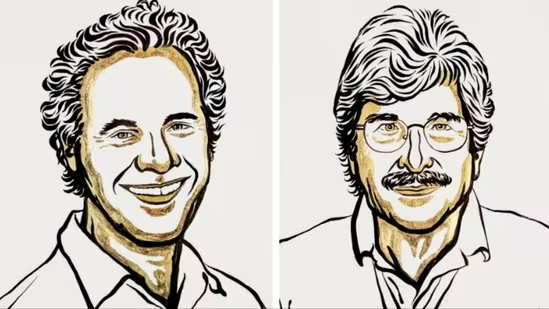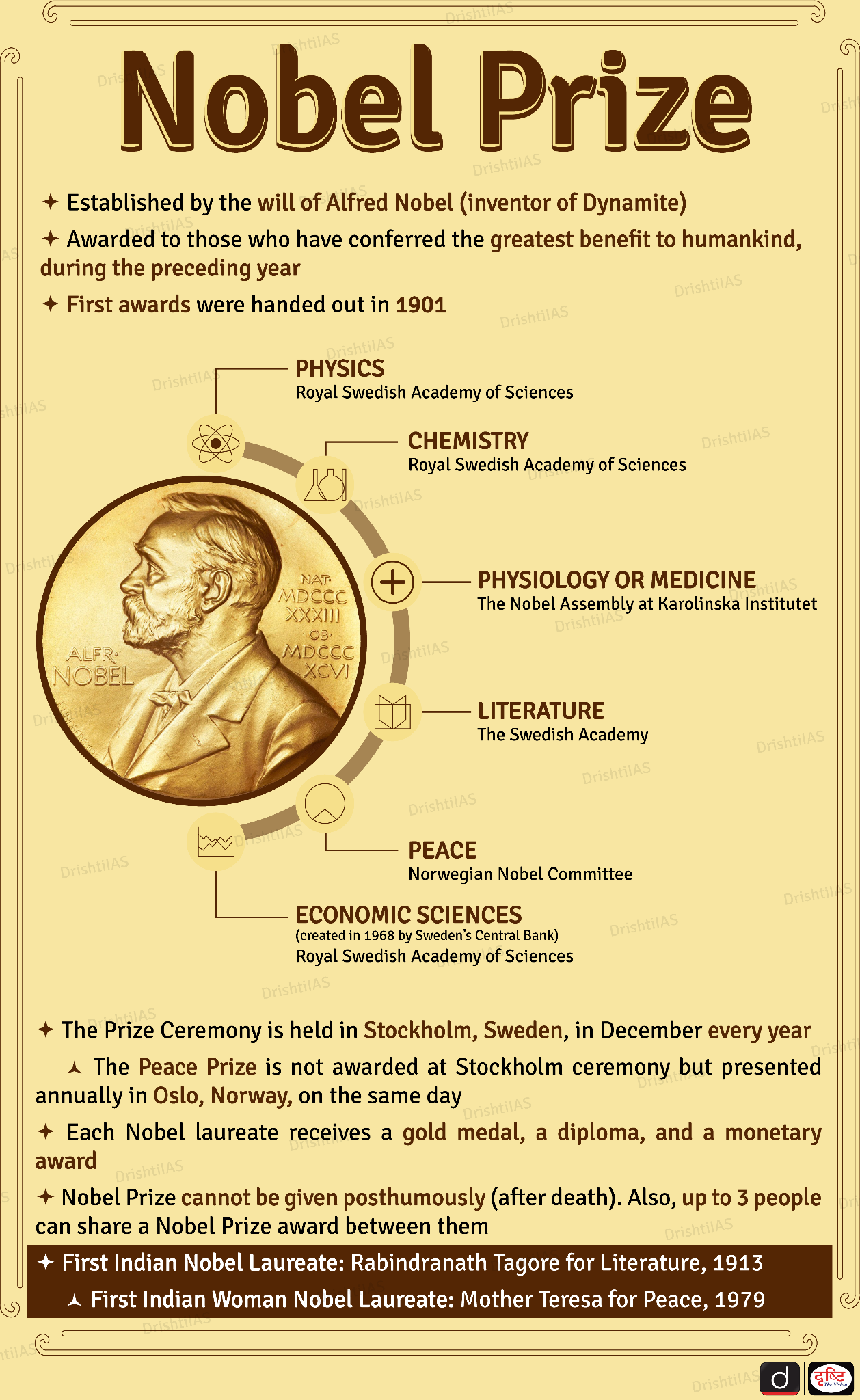Important Facts For Prelims
Nobel Prize 2024 in Physiology or Medicine
- 10 Oct 2024
- 6 min read
Why in News?
Recently, the 2024 Nobel Prize in Physiology or Medicine was awarded to Victor Ambros and Gary Ruvkun by the Nobel Assembly at Karolinska Institutet in Stockholm, Sweden.
- The scientists won the esteemed prize for the discovery of microRNA and its role in post-transcriptional gene regulation.
Note:
- The 2023 Nobel Prize in Physiology or Medicine was awarded to Katalin Karikó and Drew Weissman for their work on messenger Ribonucleic Acid (mRNA).
- The 2024 Nobel Prize in Physics has been awarded to John J. Hopfield and Geoffrey E. Hinton, for modern artificial neural networks (ANNs) and machine learning (ML).
What Discovery of microRNA led to the Nobel Prize?
- Early Research:
- C. elegans Model: Ambros and Ruvkun studied the roundworm C. elegans to understand tissue development.
- Mutant Strains: They analyzed mutant strains lin-4 and lin-14 with abnormalities in their genetic programming.
- Ambros' Research:
- Ambros found that lin-4 suppressed lin-14 activity but couldn't determine how.
- He cloned lin-4 and discovered a short RNA molecule without protein-coding potential. It suggested the RNA molecule might inhibit lin-14.
- Ruvkun's Research:
- He found that lin-4 didn't block lin-14 mRNA production but regulated it later by inhibiting protein production. A short lin-4 sequence matched key complementary segments in lin-14 mRNA.
- Ambros and Ruvkun found that lin-4 microRNA attaches to lin-14 mRNA and blocks protein production.
- Significance:
- let-7 discovery: Ruvkun's group later discovered let-7, a microRNA present throughout the animal kingdom.
- Current understanding: The microRNAs are abundant and play a crucial role in gene regulation across multicellular organisms.
Note:
- Lin-4: It is a microRNA, identified from a study of developmental timing in the nematode Caenorhabditis elegans. It was the first to be discovered of the miRNAs, a class of non-coding RNAs involved in gene regulation.
- lin-14: It is a heterochronic gene that controls the timing of developmental events in the nematode Caenorhabditis elegans.
- Heterochronic genes are genes that control the timing of cell and tissue development in an organism.
What are microRNAs?
- The body synthesizes proteins through a complex process involving two main steps: transcription and translation.
- In the transcription step, a Deoxyribonucleic acid (DNA) sequence in the cell nucleus is copied into messenger Ribonucleic Acid (mRNA).
- The mRNA then exits the nucleus, moves through the cell fluid, and attaches to a ribosome.
- In the translation step, transfer RNA (tRNA) delivers specific amino acids to the ribosome, where they are linked together in the sequence dictated by the mRNA to form the protein.
- Micro RNA (miRNA) plays a regulatory role in protein production by binding to and silencing mRNA at a specific stage in the process.
- This regulation occurs through a mechanism called post-transcriptional gene regulation, ensuring protein synthesis is controlled.
About the Winners
- Ambros and Ruvkun are both American biologists. Ambros currently works at the Programme in Molecular Medicine at the University of Massachusetts.
- Ruvkun is a professor of genetics at Harvard Medical School and conducts research on microRNA and RNA interference.
- H. Robert Horvitz, under whom both biologists worked as postdoctoral fellows, won the Nobel Prize in Physiology or Medicine in 2002.
- Ambros was the first to clone a microRNA, and Ruvkun cloned the second, marking significant milestones in the field.
What are the applications of the Discovery?
- Abnormal Regulation and Diseases:
- Cancer: Abnormal microRNA regulation can contribute to cancer development.
- Mutations: Mutations in microRNA genes have been linked to conditions like hearing loss, eye, and skeletal disorders.
- Future Applications:
- While microRNAs hold great potential, there are currently no direct clinical applications.
- Further research and a deeper understanding of microRNAs are necessary for future applications.
UPSC Civil Services Examination, Previous Year Question (PYQ)
Q. Who among the following discovered heavy water? (2008)
(a) Heinrich Hertz
(b) H.C. Urey
(c) G. Mendel
(d) Joseph Priestley
Ans: (b)


.png)





